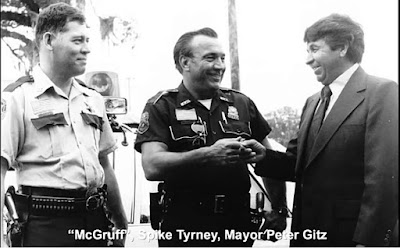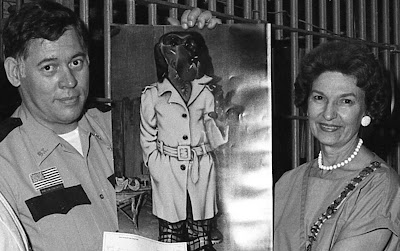"McGruff" Is Busy, Involved Deputy
COVINGTON-- Sergeant Winston Cavendish of the St. Tammany Parish Sheriff's Department is quite a character. His very personality could be used to define the word. He's a man brimming with creative ideas who expends enormous amounts of energy carrying out a wide variety of service and educational programs and projects.
And he is an empathetic fellow who brightens the community with his ready humor and his genuine lover of mankind.
Cavendish was born in south Louisiana, but began his career in a province hundreds of miles to the north. He later returned to his home state and on July 15, 1979, joined the Mandeville Police Department.
"I remember on my third day out of patrol my partner, "Hoot" Strain, had been asking me about how we policed in the north, and I'd been telling him the different ways," he said. At approximately 2:00 a.m., we came up to a stop sign and I asked how many automobile accidents had taken place on that corner. He said, 'This month, about three.' I told him I'd show him how to prevent any more.
"I got out of my car, unfolded my hunting knife, and proceeded to whack and cut all the vines and brush that covered that stop sign," Cavendish continued. "Hoot watched me with an interesting smile on his face. When I finished, I said, 'You've really learned something tonight, haven't you , Hoot?' And he said, 'I sure have. I've never seen a man cut poison oak with his bare hands like that before."
"I spent a lot of time itching and pacing after that," he continued. ""The big fancy policeman had learned something from the country policeman the hard way."
After a nearly two-year stint as assistant chief of police in Mandeville, Cavendish was hired by then newly elected Sheriff Patrick Canulette as public information officer. Since that time, Cavendish has been instrumental in carrying out the Sheriff's ideas and many of his own as well.
Neighborhood Watch, a program of local community awareness organization and action based on a national sheriff's association program, was begun in St. Tammany in 1980. There are now 72 groups containing a total of approximately 15,000 members in the parish.
"It all started with one neighborhood in Slidell," said Cavendish. "It was overrun with rats, ditches overflowed with raw sewage and former criminals lived in it. The citizens got together, and after a while they were able to re-do the roads and improve the drainage. They made what had been a terrible area into a garden paradise. Now they have their own community house, a senior citizen center where food is distributed to senior citizens, and even a park with their own flag.
"Through this kind of citizen cooperation, crime has actually been displaced," he continued.
Currently, a coalition of all parish Neighborhood Watch coordinators is being organized so that ideas can be exchanged and fund raising events shared.
Drug education has been a top prority of Sheriff Canulette whose narcotics division with the help of federal, state, and local law enforcement agencies has already seized more than $365 million in illegal drugs. And Cavendish through the parish school board had been responsibile for bringing a program including talks, films, demonstrations, and even "drug sniffing dogs" Brutus and Popcorn to the students of 40 public and 14 private schools.
The word "workaholic" might have been coined for Sgt. Cavendish. His projects are too numerous to mention. The shelves of his small office are brightened by the man fabric faces comprising "The Crime Prevention Puppet Theater," a growing troupe whose scripts Cavendish writes and whose movements he initiates. He works with the Junior Deputies in conjunction with the Louisiana Forestry Commission, and with many, many more groups and individuals.
But there is one project for which Winston Cavendish is probably best known, for without him there would be no McGruff, the Crime Dog.
"The National Crime Dog wandered into my life approximately four years ago," she said. "I was in Louisville, Kentucky, at an international crime prevention conference, and they were looking for a crime prevention logo. There was a round table discussion to pick out the type of animal that would best typify crime prevention, and everyone like the idea of a dog.
"They had come up with Tackie Dog, a German police dog, "J. Edgar Dog" an English bulldog, and Superdog. They were all of a more militant nature.
Cavendish suggested that a bloodhound might be a more appropriate symbol since it could stick its nose into every local home town in the country. "He'd be a sleuth from right down the street who would not be benevolent, but protect people and be involved," said Cavendish.
The character was decided upon and was named, and Cavendish was one of the first people in the United States to receive the fabric head and paws that would transform him into McGruff.
"At first, I got mixed reactions," said Cavendish. "As a deputy running around dressed up like a dog, I put whatever reputation I had at that point in time on the line."
But Cavendish as McGruff has taken nothing but positive strides over the years. He has appeared in parades and at different benefits throughout the country. He has ridden in a tractor with a wagon load of corn in Iowa, passed out literature while ice skating in Texas, and survived a helicopter landing in a windstorm in Pittsburg where he became blindly ill while having to remain in costume for an additional four hours.
He was given the keys to Selma, Alabama, named honorary Secretary of State of Louisiana and honorary principal at Chahta Ima School in Lacombe where McGruff Day is celebrated once a year.
A recent Roper poll as of a year ago showed that 52 percent of the people in the United States knows that McGruff exists and what he stands for. It took Smokey the Bear 41 years to get that much name recognition.
A McGruff stamp is going to be unveiled at the Postmaster General's office in Washington, D.C. July 1, he continued. "And on October 1 the first stamps will be at post offices across the country. A Smokey the Bear stamp will come out right before that."
And where will Winston Cavendish go from here? Many miles in many directions no doubt if history gives any indication.
End of article St. Tammany Farmer Newspaper January 1984
















